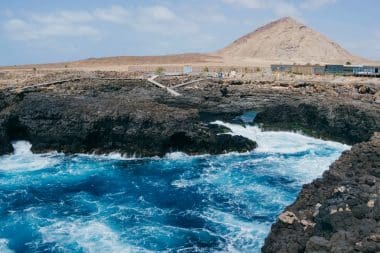Windsurfers and surfers have been drawn to Sal in the Atlantic Ocean since the 1970s. It is one of the nine inhabited islands of Cape Verde and is known for its strong trade winds during the winter months. These lead to perfect waves, which are otherwise quite difficult to find at this time of year.
Sal originally consists of volcanic magma that rose from the sea millions of years ago. Nowadays, there is not much to see of this past due to various weather conditions. The landscape is flat and characterized by limestone and dunes. It is only interrupted by isolated oases and quiet volcanoes.
As the name of the island suggests – Sal is Portuguese and means salt – the export of this raw material was once the island’s largest source of income. In the meantime, the locals live mainly from tourism, which is why the salt production facilities have been shut down. Only small quantities are produced for personal use.
As a result of the warm climate, Sal has a year-round bathing season with water temperatures averaging more than 20 degrees Celsius. This is especially pleasing to snorkeling fans, who get the opportunity to swim with lemon sharks due to these conditions. These sea creatures can grow up to 3.5 meters long and are mainly found on the east coast of the island.
The sights of Sal
Palmeira
West of Espargos, the capital of the island, lies the bustling port city of Palmeira. It is still an important location for the island’s trade today. Both the colorful boats of the locals and the houses of the city with its Portuguese influence offer themselves as ideal photo motifs. In the evening you can end the day comfortably in one of the beautiful bars or restaurants.
Buracona
This small cove is located in the north-western part of Sal, just a few kilometres from Palmeira. If you want to experience the full beauty of this sight, you should visit it at noon. Because only when the waves are calm and the sunlight is ideal can the Olho Azul – the blue eye – be discovered. This is a hole in the black rocky bay with bright turquoise blue sea water. Divers and snorkelers can also explore the beauty of this area underwater.
Santa Maria
In the south of the island, the town of Santa Maria delights tourists with its small, pastel-coloured houses. If you are still looking for a little souvenir, you will certainly find it in one of the many souvenir shops. In addition, most of the luxury hotels and holiday resorts are located here, where you can enjoy your holiday in a relaxed way. The real attraction of Santa Maria is its approximately eight-kilometre-long beach. This invites you to sunbathe on bright white sand and take endless walks. For the more adventurous, activities such as kayaking, fishing or deep-sea diving are also offered.
The Salt Pans of Pedra de Lume
What was originally created by a volcanic explosion is now considered one of the most popular sights on the island. In a crater with a diameter of almost one kilometer in length, seawater collected, which now has an extremely high salt content. This happened because the water evaporated due to the high temperatures and more and more salt remained. The high concentration makes it possible to float on the surface of the water like in the Dead Sea without sinking.
Botanical garden
Those looking for a change of scenery should visit the Viveiro Botanical Garden. This green oasis in the middle of the desert-like landscape is the ideal retreat to relax in the shade of the palm trees. Attached is a cactus garden and a small zoo where parrots, monkeys, donkeys and guinea pigs can be observed.
Culinary specialties on Sal

On Sal, as on most islands in the world, fish dishes and seafood dominate the menus of the restaurants. Swordfish, mackerel, mussels and crabs are preferred, as they are of fresh quality thanks to regional fishing. The tuna steak is also very popular.
Given the location of the islands, the Portuguese and African influences can be seen in the dishes. Basically, the food on Sal is always hearty and varied.
The national dish of the inhabitants is the so-called cachupa. In addition to the main ingredients corn and beans, this stew also contains onions, pumpkin, tomatoes, sweet potatoes and cabbage. Depending on your taste, this dish can be modified by adding fish or meat.
You should also try feijoada (a bean stew) and the caldo de peixe (a fish soup).
As a result of the continuous summer temperatures, many exotic fruits grow on Sal, such as papayas, mangoes or guavas, which are ideal as desserts with their sweet taste.
Facts about Sal
- Location: Sal is located in the Atlantic Ocean, about 500 kilometers west of Africa.
- Size: The island has an area of about 216 square kilometers.
- Population: Sal has a population of about 33,000 people.
- Capital: The capital of the island is Espargos.
- Economy: Sal is best known for tourism. The island has some of the most beautiful beaches in Cape Verde and is a popular destination for sun worshippers and water sports enthusiasts. Sal is also an important location for salt production.
- Climate: The climate on Sal is warm and dry all year round, with average temperatures between 25 and 30 degrees Celsius.
- Places of interest: Attractions on Sal include the Santa Maria kitesurfing beach, the salt flats of Pedra de Lume, and the whaling museum in Santa Maria.
- Airport: Amílcar Cabral International Airport on Sal is the main airport in Cape Verde and an important hub for international flights.
- Language: The official language in Sal and Cape Verde is Portuguese, but Creole and English are also commonly spoken.
- Currency: The currency on Sal and Cape Verde is the Cape Verdean escudo.




